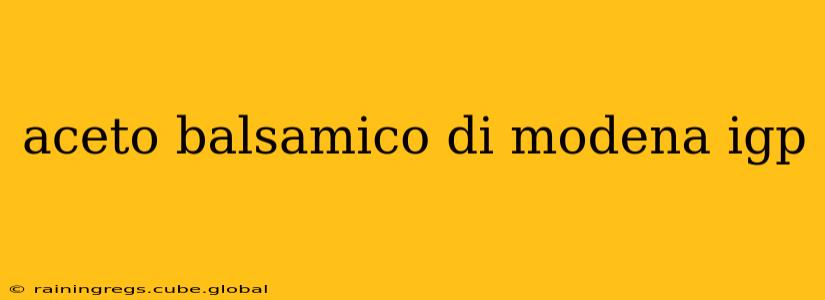Aceto Balsamico di Modena IGP (Protected Geographical Indication) is more than just a condiment; it's a culinary treasure, a testament to centuries of tradition, and a symbol of Italian gastronomic excellence. Unlike its mass-produced cousins, the true Aceto Balsamico di Modena IGP boasts a complex flavor profile, a rich history, and a production process that is strictly regulated to guarantee its authenticity and quality. This comprehensive guide will delve into the nuances of this exceptional vinegar, exploring its history, production, characteristics, and uses.
What is Aceto Balsamico di Modena IGP?
Aceto Balsamico di Modena IGP is a balsamic vinegar produced in the province of Modena, Italy, under strict guidelines defined by the European Union's Protected Geographical Indication (PGI) system. This designation guarantees that the vinegar originates from a specific area and adheres to traditional production methods, ensuring superior quality and consistent characteristics. The IGP label protects the name and guarantees that the product meets stringent standards. It's crucial to look for this label to ensure you're purchasing the genuine article.
What Makes Aceto Balsamico di Modena IGP Different?
The difference lies in the production process and the ingredients. While many balsamic vinegars exist, only those adhering to the IGP regulations can carry the prestigious title. This means:
- Specific Grape Musts: The must (cooked grape juice) must come from specific grape varieties grown in the Modena province.
- Traditional Production Methods: The must undergoes a lengthy aging process, typically in a series of progressively smaller barrels made from different types of wood (e.g., oak, chestnut, mulberry). This slow aging process concentrates the flavors and develops the complex aroma.
- Strict Quality Control: The entire process is subject to rigorous checks and inspections to guarantee compliance with the IGP regulations.
This meticulous process results in a vinegar with an intensely sweet and sour flavor, a complex aroma, and a syrupy consistency. The aging process significantly impacts the final product, leading to variations in color, viscosity, and taste.
How is Aceto Balsamico di Modena IGP Made?
The production of Aceto Balsamico di Modena IGP is a labor of love, a process handed down through generations. It's a multi-stage journey involving:
- Grape Harvesting and Pressing: Selected grapes are harvested and pressed to extract the must.
- Cooking and Concentration: The must is cooked down to reduce its volume and concentrate its sugars.
- Aging: This is the most crucial step. The cooked must is transferred to a series of barrels, usually made from different woods, where it ages for a minimum of 12 months. Some producers age their balsamic for significantly longer periods, even decades! The wood type impacts the final flavor and aroma, adding notes of vanilla, spice, and oak.
- Bottling and Labeling: After the aging process, the balsamic vinegar is bottled and labeled with the IGP mark, a sign of authenticity and quality.
What are the Different Grades of Aceto Balsamico di Modena IGP?
While there isn't a formal grading system within the IGP regulations, the aging period significantly impacts the final product's quality and characteristics. Generally, longer aging results in a more concentrated, complex, and expensive product. You will often find different age designations or descriptions on the bottle, reflecting the duration of the aging process.
How to Taste and Use Aceto Balsamico di Modena IGP?
The best way to appreciate Aceto Balsamico di Modena IGP is to taste it plain, allowing its complex flavors to unfold on your palate. It's a fantastic condiment for:
- Salads: Adds a sweet and tangy depth to leafy greens and other vegetables.
- Cheese: Pairs beautifully with hard cheeses, like parmesan or pecorino.
- Fruit: Drizzle over fresh strawberries or figs for a delightful contrast.
- Meat: Adds a rich and nuanced flavor to grilled meats and roasted vegetables.
- Desserts: Its sweetness makes it ideal for drizzling over cakes, ice cream, or even fresh fruit desserts.
Experiment and discover your favorite ways to use this versatile and flavorful ingredient.
What is the Difference Between Aceto Balsamico di Modena IGP and Traditional Balsamic Vinegar of Modena?
While both originate from Modena, the crucial difference lies in the production and aging process. Traditional Balsamic Vinegar of Modena (Aceto Balsamico Tradizionale di Modena) follows an even stricter, longer, and more traditional production process, resulting in a product that is typically more aged, viscous, and expensive. It doesn't fall under the IGP regulation and uses older, more established methods.
Where Can I Buy Authentic Aceto Balsamico di Modena IGP?
Look for the IGP label to ensure authenticity. Specialty food stores, gourmet shops, and online retailers often carry genuine Aceto Balsamico di Modena IGP. Be wary of incredibly cheap options, as they are likely not authentic.
Conclusion:
Aceto Balsamico di Modena IGP is a culinary masterpiece, a product of meticulous craftsmanship and dedication to tradition. Its unique flavor profile and versatility make it a prized ingredient in both simple and complex dishes. By understanding its production process and characteristics, you can fully appreciate its exceptional quality and elevate your culinary creations.
